Physical Address
304 North Cardinal St.
Dorchester Center, MA 02124
Physical Address
304 North Cardinal St.
Dorchester Center, MA 02124
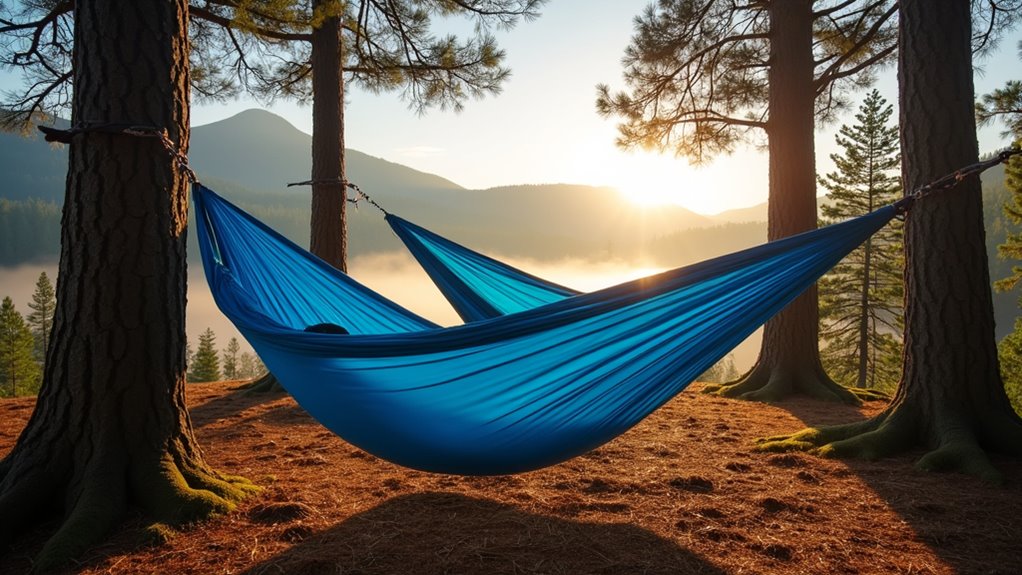
Achieve superior sleep quality and camping comfort as modern hammocks revolutionize outdoor relaxation, but choosing the right setup requires knowing these essentials.
Studies show that campers who use hammocks report 23% better sleep quality compared to those using traditional ground tents. If you’ve been hesitating to switch from your familiar tent setup, you’ll find that camping hammocks offer an impressive mix of comfort and practicality. They’re typically lighter, more portable, and often less expensive than quality tents. Whether you’re a weekend warrior or a seasoned backpacker, understanding the key features and options will help you make the smartest choice for your outdoor adventures.
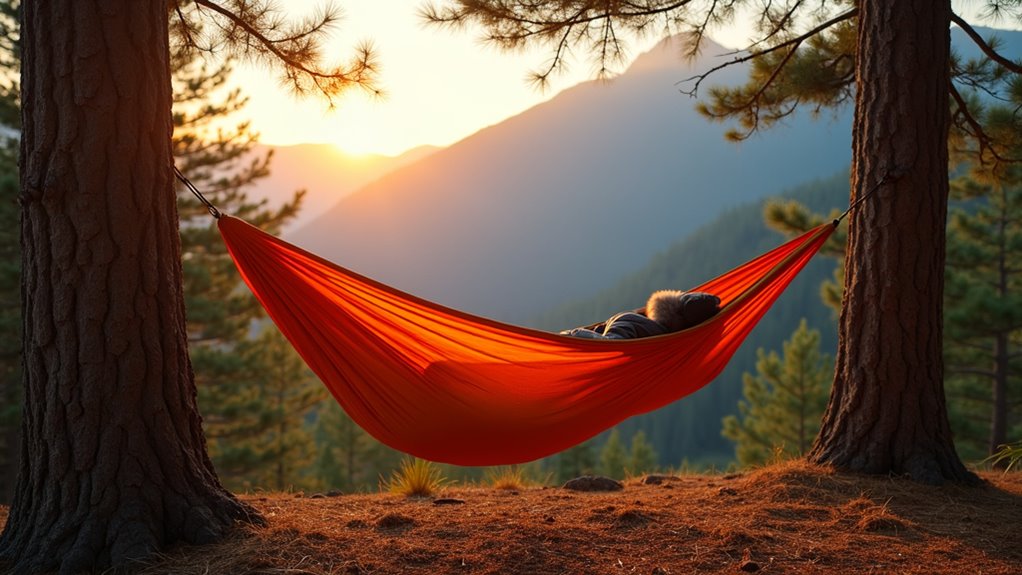
While traditional tent camping remains popular, camping hammocks offer compelling advantages that make them an excellent choice for outdoor enthusiasts.
You’ll appreciate how quickly you can set up your camp – experienced hammockers need just a couple of minutes to secure their straps around trees. Unlike tents, you won’t need to search for flat ground or clear debris before setup. The elevated sleeping position means you’ll never worry about water pooling underneath during rainstorms.
Hammock camping eliminates the frustration of finding level ground – just locate two sturdy trees and you’re minutes away from relaxation.
You’ll likely find sleeping in a hammock more comfortable than lying on hard ground, as it promotes better spinal alignment and reduces pressure points. The gentle rocking motion can help you fall asleep faster and achieve deeper sleep cycles. Hammocks can also provide protection from insects and small animals while camping.
Best of all, hammocks pack down small and light, saving valuable space in your backpack while reducing weight. They’re also environmentally friendly, minimizing impact on both trees and ground vegetation.
Camping hammocks come in diverse styles and configurations to match every outdoor enthusiast’s needs. When choosing your ideal hammock, you’ll need to evaluate capacity, materials, and intended use to get the best value for your money.
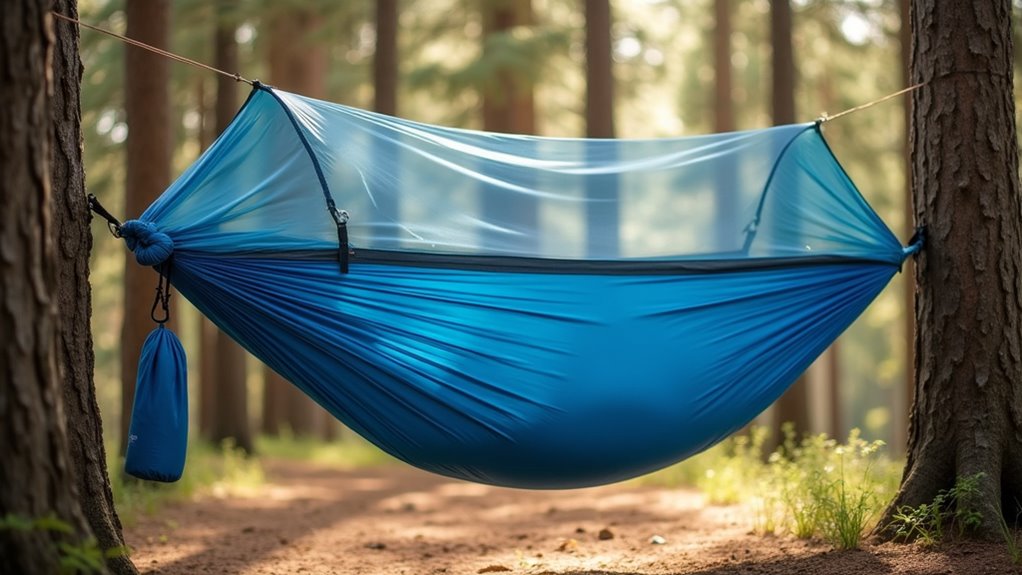
Before investing in a camping hammock, you’ll need to evaluate several essential features that directly impact your comfort, safety, and overall camping experience.
Look for models offering enough space to lie diagonally, with widths between 1.2 to 1.6 meters providing ideal comfort for most users. For optimal setup, ensure the hammock can be hung with a 30-degree angle between the suspension straps and tree.
Prioritize hammocks with high strength-to-weight ratios and easy setup systems. Check the weight capacity to verify it’ll support both you and your gear.
Consider models that accept add-ons like bug nets, tarps, and insulation for versatility in different conditions.
Don’t forget to factor in the suspension system – you’ll need reliable tree straps, carabiners, and protective webbing.
For cold-weather camping, plan for proper insulation with underquilts or sleeping pads to prevent heat loss through the hammock bottom. Hammocks are a wise option for jungle camping as they can help you avoid ground-based hazards and provide a comfortable, elevated resting spot.
When selecting your perfect camping hammock, several trusted brands and models stand out in the market. These top picks come from analyzing 361 detailed reviews of various hammock models.
Warbonnet leads the pack with their highly-rated Ridgerunner, scoring 9.1/10 for its exceptional durability and comfort. You’ll also find excellent options from Hennessy and ENO, known for their quality construction and reliable performance. Essential camping gear for young adventurers is important to consider when selecting a camping hammock.
For specific needs, consider Hennessy’s 4Season Expedition Zip for cold weather camping or Sunyear’s built-in bug net model for insect protection.
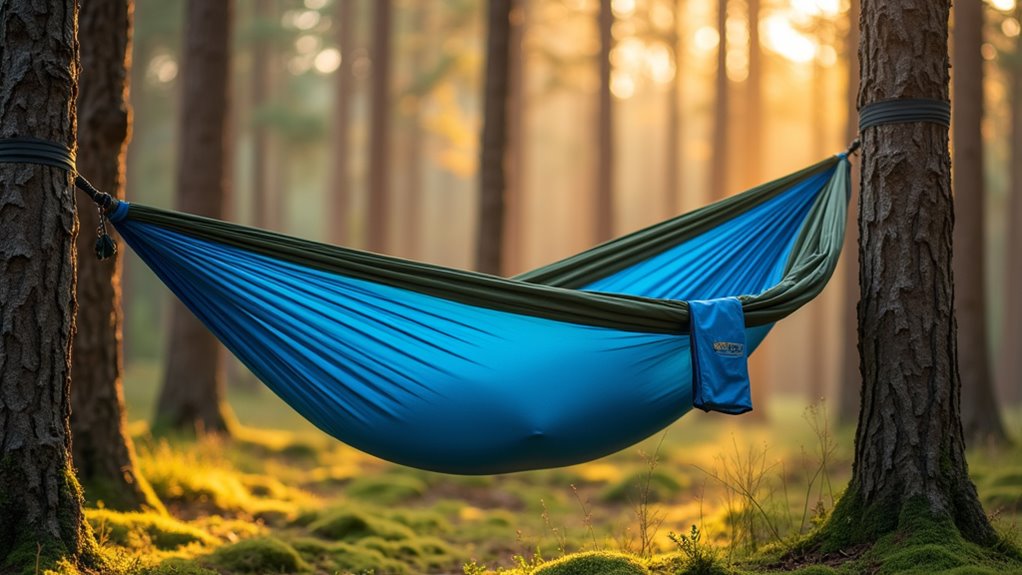
Success in hammock camping starts with mastering the setup process. You’ll want to hang your straps at a 30-degree angle and position your hammock entrance at chair height for easy access. Choose polyester webbing straps over nylon to prevent unwanted stretching and slippage.
Look for trees spaced 12-26 feet apart, depending on your hammock model. When attaching your straps, use a simple lashing method or Marlin Spike hitch with climbing-rated carabiners for security. You don’t need complex knots – just make sure your setup is level and properly tensioned. For detailed visual instructions, check out The Ultimate Hang authored by Derek Hansen.
Mastering the art of hammock camping can greatly enhance your outdoor experience. Remember to inspect your gear regularly and carry a basic repair kit. If you’re dealing with uneven terrain or wind, adjust your setup height and angle accordingly.
With practice, you’ll become faster and more confident at achieving the perfect hang.
Getting the most comfort from your hammock requires understanding a few key principles of design and setup. You should focus on achieving a flat diagonal lay to eliminate the banana curve that can make sleeping uncomfortable. Maintaining proper sag height helps prevent common issues like shoulder squeeze and calf pressure.
A diagonal position in your hammock creates the ideal flat sleeping surface, preventing uncomfortable curvature and ensuring restful sleep.
Choose a hammock that’s both longer and wider than you might think necessary, as this extra space allows for ideal positioning. Experience ultimate comfort with camping hammocks that provide a cozy and relaxing outdoor retreat.
Select breathable materials like ripstop nylon for temperature control and durability. Make sure your hammock includes adjustable straps and cinch buckles for easy setup and customization. Consider models with integrated bug nets that can be fully sealed for protection against insects.
The right combination of features doesn’t have to break the bank. Models like the Tempest offer quality sleep at affordable prices, while options like the Chameleon provide premium comfort for those willing to invest more.
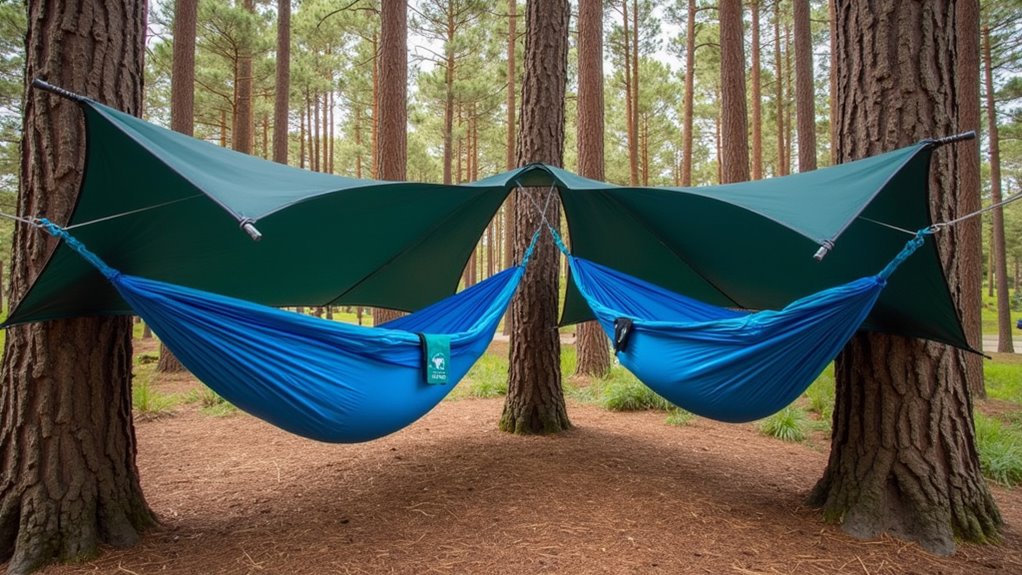
A comfortable hammock setup means little without proper weather protection and safety measures in place. You’ll need a reliable tarp or rain fly positioned above your hammock with enough coverage to shield both you and your gear from rain. Using drip lines near suspension helps prevent water from seeping into your hammock during rainfall.
Don’t skimp on waterproofing – treat your hammock’s seams and fabric with water-resistant spray for added protection.
For cold weather camping, invest in an underquilt and top quilt combination. These provide essential insulation beneath and above you, while inflatable or closed-cell foam pads offer additional warmth. Plus, packing warm layers can be crucial for surviving cold-weather camping.
Always check weather forecasts before heading out and choose elevated campsites to avoid flooding risks. When setting up, inspect trees carefully for stability and maintain awareness of potential hazards like lightning or high winds.
Keep emergency supplies and a first aid kit readily accessible.
To maximize your hammock’s lifespan and performance, proper maintenance requires consistent care and attention to detail.
Keep your hammock clean by using mild detergent and either hand washing or machine washing on a gentle cycle, depending on the material. To prevent mold growth, ensure your hammock is completely dried in sunlight after exposure to rain or moisture. Always air dry in the shade to prevent fabric damage.
Properly caring for your camping furniture is essential for ensuring long-term use and enjoyment during your outdoor adventures.
Follow these essential maintenance steps:
Don’t forget to perform a thorough inspection before each camping season and avoid exceeding the weight capacity to guarantee safe, long-lasting enjoyment of your outdoor investment.
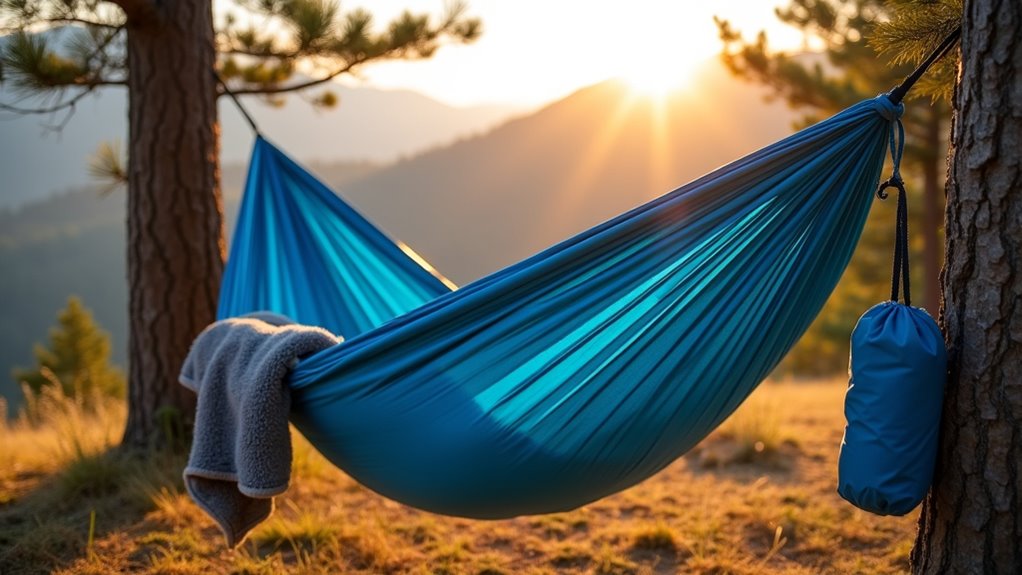
When choosing a camping hammock, your budget doesn’t have to limit your outdoor experience. Entry-level options like the ENO DoubleNest ($75) and Klymit Traverse ($65) offer reliable performance for casual camping and lounging.
Quality camping hammocks exist at every price point, with reliable entry-level options starting around $65 for casual outdoor adventures.
If you’re planning longer trips, consider mid-tier models like the Kammok Mantis ($270), which includes a tarp and enhanced features for serious outdoor use. Essential Camping Gear is also important to consider when choosing a camping hammock.
For backpackers focused on weight savings, ultralight options from Hennessy provide specialized designs with weight ratings up to 300 lbs.
If comfort’s your priority, brands like Tentsile start at $159-$199 and maximize lounging space. The Wise Owl Outfitters Kit delivers impressive 500-pound weight capacity while keeping costs affordable.
Remember to factor in essential accessories like suspension systems, bug nets, and rain tarps when planning your purchase.
Even budget-friendly options like the Grand Trunk Ultralight prove that affordable doesn’t mean low quality.
Just like a wise owl chooses the perfect branch for its perch, you’ll find your ideal camping hammock brings endless moments of outdoor serenity. Whether you’re a budget-conscious beginner or a seasoned camper, there’s a perfect hammock waiting for you. Don’t let your dreams of peaceful wilderness relaxation remain grounded – invest in a quality hammock, and you’ll be swaying among the trees in no time.